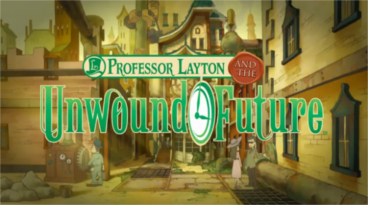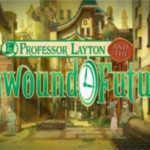
Professor Layton and the Unwound Future – Review
Excellent storytelling, which is full of gratifying surprises and intrigue.



Genre: Puzzle Adventure
Release Date: September 12, 2010
Predictions, predictions. Here are some of the bold predictions I’ve made over the past few years:
– Edible cell phones
– Brad Pitt runs for Congress
– Iraq becomes 51st state
– Jonathan Coulton wins an Oscar for Best Song
– Blizzard announces its new massively multiplayer online roleplaying game: Lego Twilight
Impressive, no? Okay, no. BUT. The thing about predictions is that if you make enough of them, just like a broken clock, you end up being right every so often.
And one prediction I have been most definitely right about is this one: The Nintendo DS will become a great home for new adventure games.
It’s hard to deny how magnificently right I’ve been on this one, with the release of such games as Nine Hours Nine Persons Nine Doors, Time Hollow, and the Hotel Dusk series and Ace Attorney franchise, just to name a few.
But arguably standing top hat and shoulders above them all is the Professor Layton series. Starting in 2008 with Professor Layton and the Curious Village, this sparkling collection of adventures has successfully mixed great storytelling with a dizzying array of fun-to-solve puzzles.
Professor Layton and the Unwound Future is a beautiful example of the very best practices perpetrated by the best game studios: Taking a good game concept and refining it further and further with each installment. Level 5 displays this admirable behavior with this, the third game in the series. Everyone loved the first game but criticized its reliance on repeating puzzle types too often, as well as including those much-hated matchstick puzzles. The second game, Professor Layton and the Diabolical Box successfully addressed both of these problems.
Professor Layton and the Unwound Future‘s improvements are in the storytelling. While the stories of all three games have been excellent, by the end of Unwound Future I was picturing the terrific anime film that could be made from the storyline in the game. That’s how good it is.
For those of you who may be new to the series, I’ll give you the broad strokes of the mythos: Professor Layton is a tophat-wearing British researcher who spends most of his time as a sort of puzzle-solving detective. His constant companion is his apprentice, an eager young boy named Luke. And I do mean constant companion, friends. This kid seems to have practically no other life. He never seems to need to be in school, or do homework, or other activities appropriate to other 12-year-olds. What the hell, the game is Japanese, just go with it.
Anyway, in Professor Layton’s world, all conflicts, all locks and most conversations are resolved by solving puzzles. You get used to this convention pretty quickly, sort of like you get used to the ubiquity of available sex in the world of a porno movie (or so I’ve heard).
This time around the story is more personal than in the first two games. The story begins with the very public demonstration of nothing less than a time machine. When the test goes horribly wrong, the games’s afoot, and our dynamic duo get plunged into an altered version of London and a lot of mysteries regarding identity, guilt, and retribution. And a whole lot of yummy puzzles.
Oh, the puzzles! This is, quite simply, a magnificent collection of head-scratchers. The variety, range, and quality are absolutely first rate. No matter what kind of puzzle you enjoy, chances are you’ll find it here. There are sliders, Chinese wood block puzzles, logic puzzles, jigsaw puzzles, math puzzles, visual puzzles, and many many more.
The game makes admirable use of the Nintendo’s touch screen for the puzzle solving. You use the stylus to press buttons, write answers, push blocks around, you name it. There’s also a terrifically helpful feature called “Memo” that essentially lets you put a piece of tracing paper over the puzzle so that you can scribble on it to your heart’s content. Many of the puzzlers would be quite difficult to solve without this mechanic.
The game also has a built-in hint system which has been improved from the first two games. In order to access hints, you have to spend “Hint Coins” that you collect while investigating the game’s many attractive environments. There are four hints per puzzle, with the final clue costing double.
Each time you solve a puzzle, you earn a currency called “picarats” which give you access to bonus content upon finishing the game.
The puzzles range in difficulty from pretty darned easy to downright fiendish, with everything in between.
And the fun doesn’t stop there. The game comes loaded with extras. There are four optional minigames that you pick up and add to during the course of your adventure. The easiest is a picture book in which you complete stories using stickers that you find around the game world. Next is a series of challenges involving a toy car. Each puzzle is a course you have to plot, navigating obstacles using a limited number of tools. The most difficult of the optional minigames involves a parrot that you find (and get to name!). They are all fun and, if you really dig into them, add lots of hours to the game – in a good way, of course.
There are also free downloadable puzzles for those of you who like to go wi-fi with your DS.
Graphically, the game is on par with the first two. All three of the games have a very cohesive look, and the cinematics this time around are generous and uniformly excellent. There’s even a good bit of well-done voice acting.
The excellence of this game should be no surprise, considering it’s made by the same folks who brought us, in addition to the first two games in the series, Rogue Galaxy, Dragon Quest VII and the Dark Cloud series. These people know what they are doing.
I again emphasize the game’s excellent storytelling, which is full of gratifying surprises and intrigue. From the exciting opening sequence to the poignant conclusion, I was riveted by Professor Layton and the Unwound Future. I think you will be, too.
One last note: Make sure to hang in through all of the credits at the end or you might miss something!
If you liked this game, then
Play: the first two games! Otherwise, try Time Hollow
Watch: Navigator or even Flight of the Navigator
Read: The Accidental Time Machine by Joe Haldeman

Leave a Reply